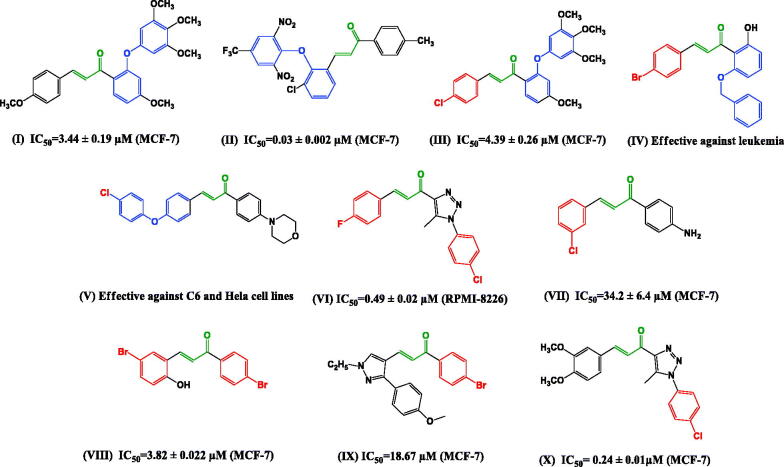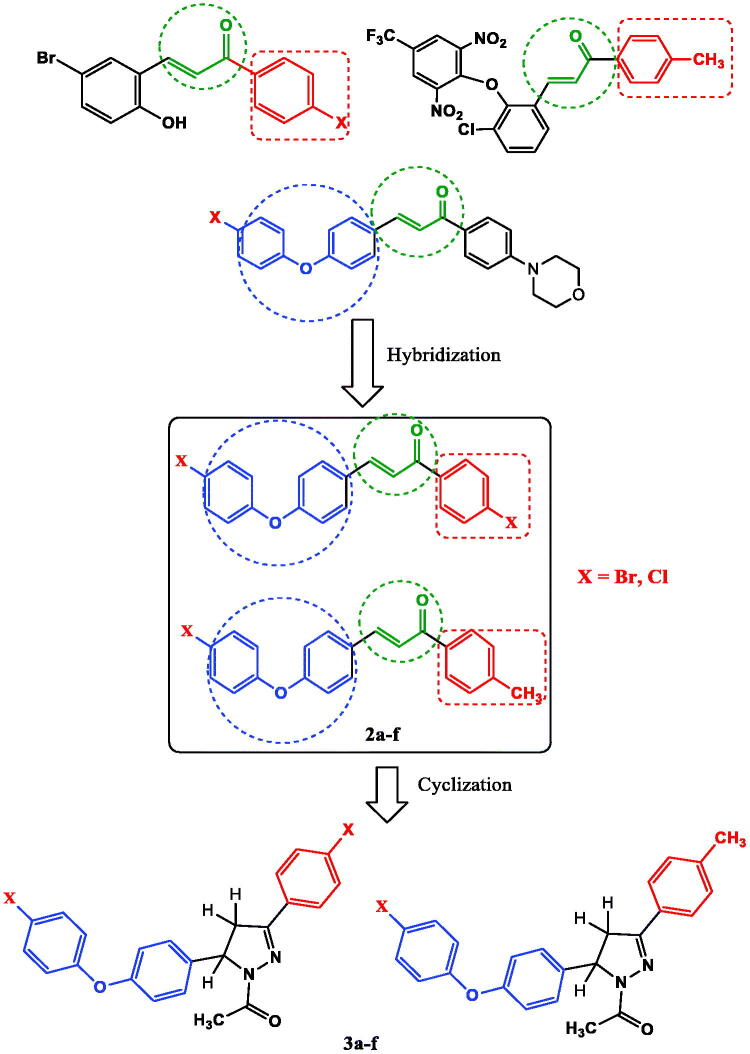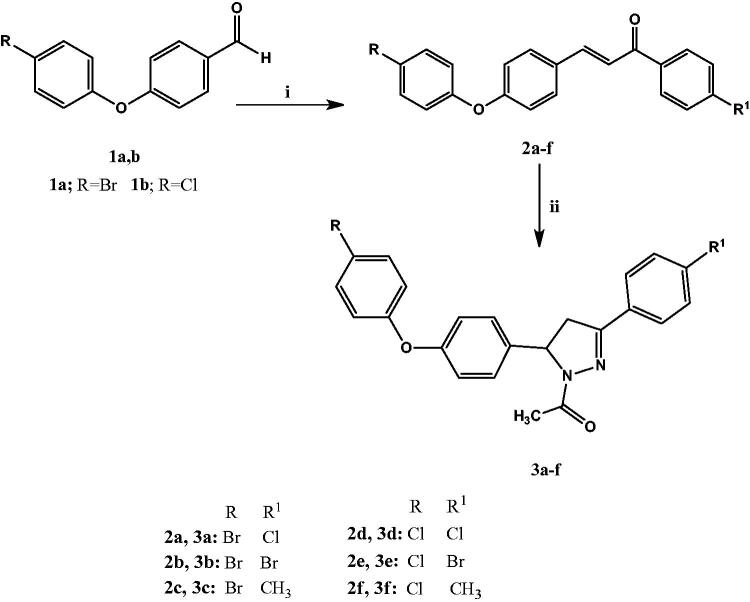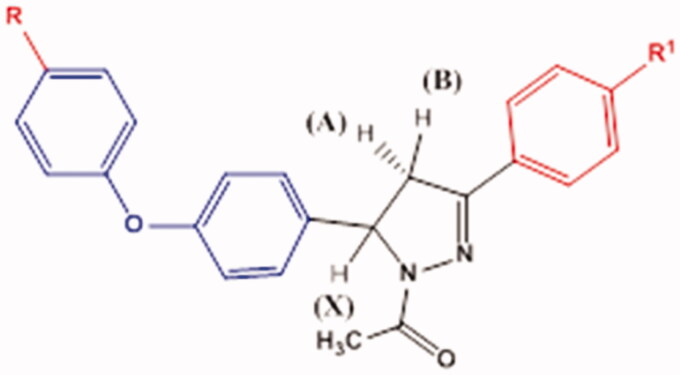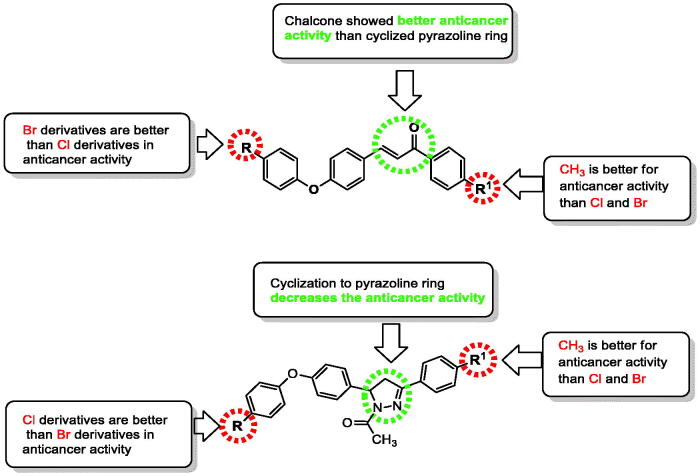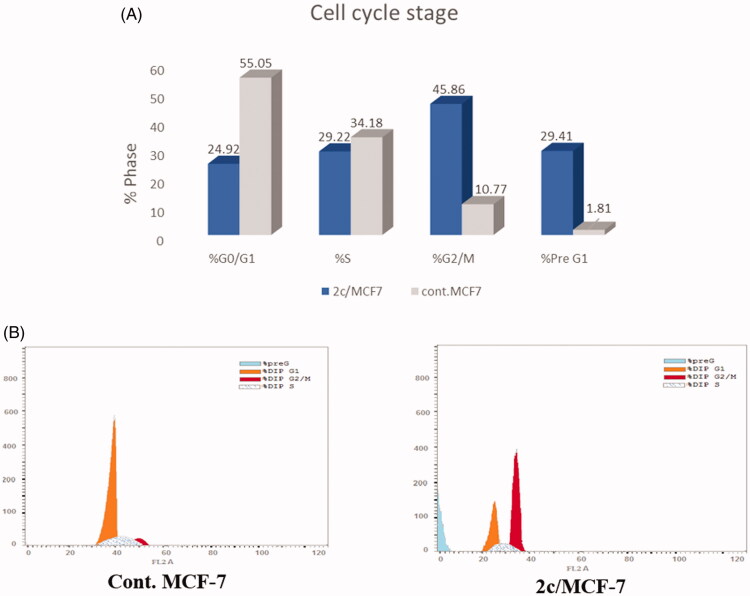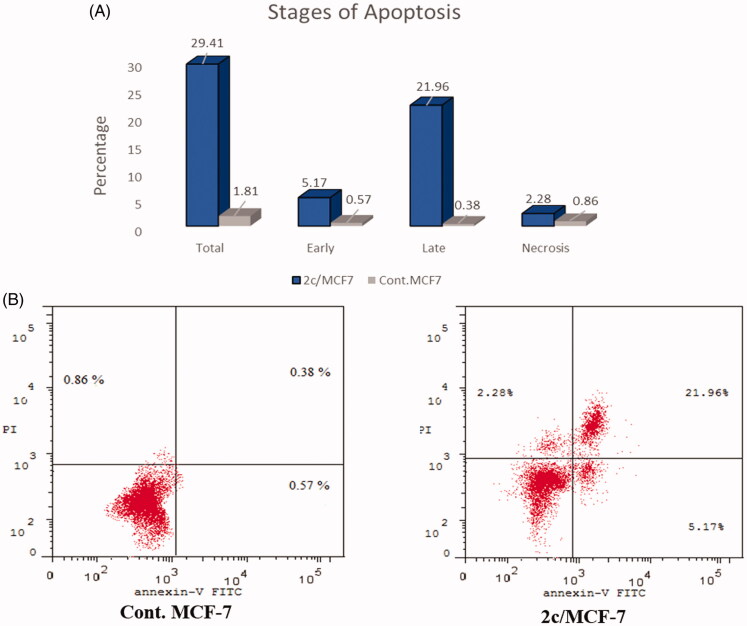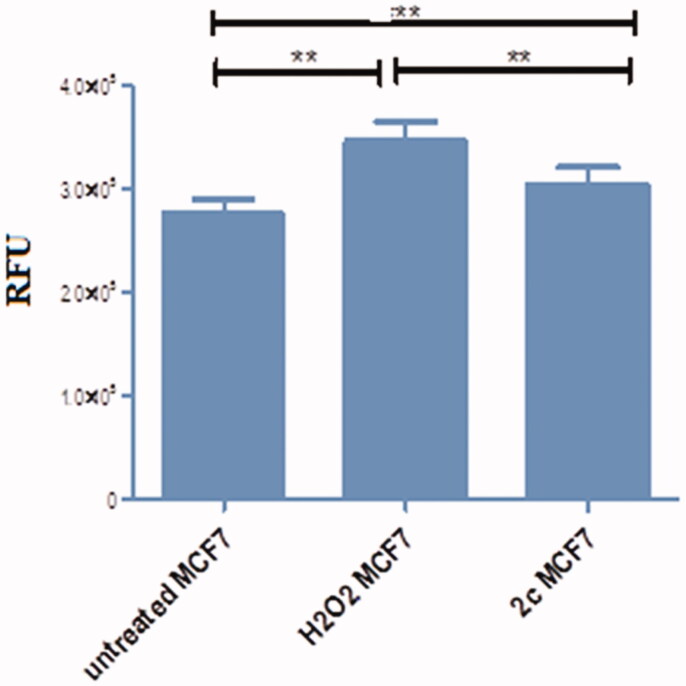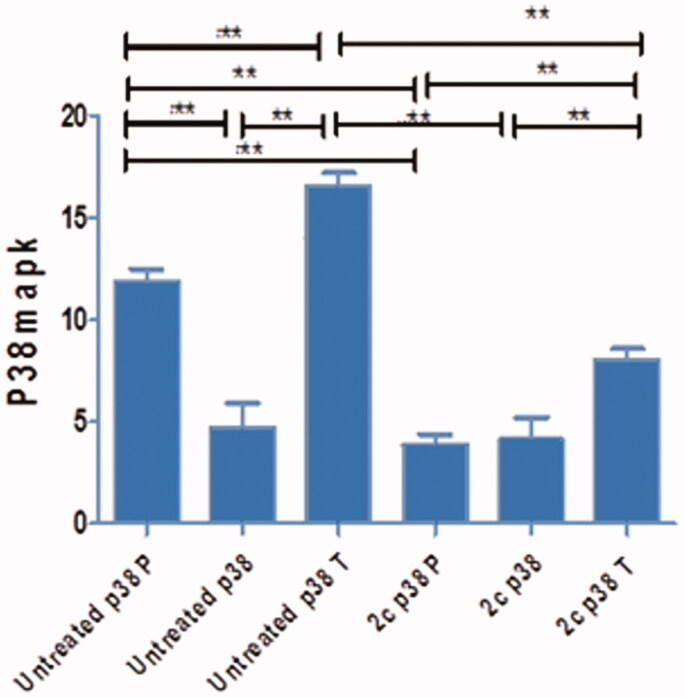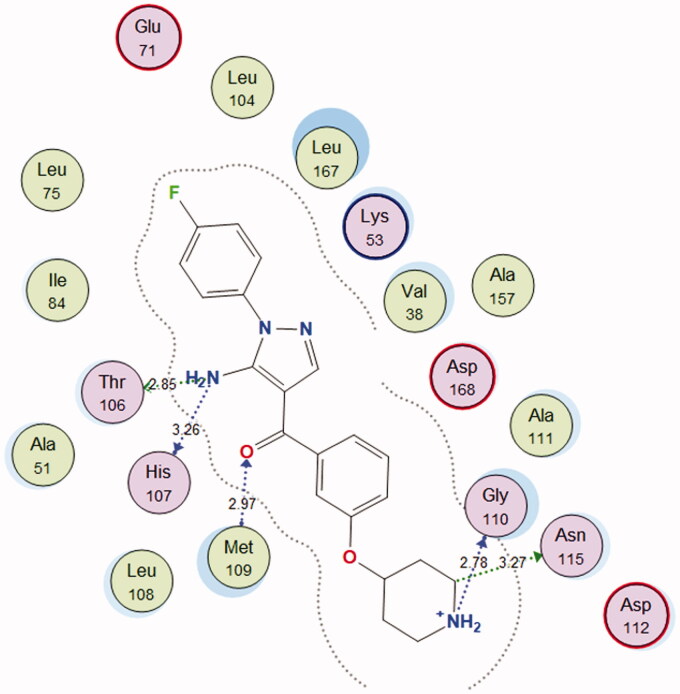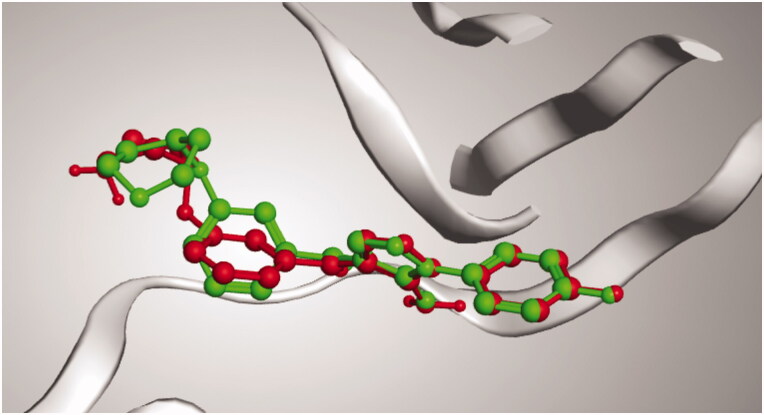Abstract
Novel halogenated phenoxychalcones 2a–f and their corresponding N-acetylpyrazolines 3a–f were synthesised and evaluated for their anticancer activities against breast cancer cell line (MCF-7) and normal breast cell line (MCF-10a), compared with staurosporine. All compounds showed moderate to good cytotoxic activity when compared to control. Compound 2c was the most active, with IC50 = 1.52 µM and selectivity index = 15.24. Also, chalcone 2f showed significant cytotoxic activity with IC50 = 1.87 µM and selectivity index = 11.03. Compound 2c decreased both total mitogen activated protein kinase (p38α MAPK) and phosphorylated enzyme in MCF-7 cells, suggesting its ability to decrease cell proliferation and survival. It also showed the ability to induce ROS in MCF-7 treated cells. Compound 2c exhibited apoptotic behaviour in MCF-7 cells due to cell accumulation in G2/M phase and elevation in late apoptosis 57.78-fold more than control. Docking studies showed that compounds 2c and 2f interact with p38alpha MAPK active sites.
Keywords: Halogenated chalcones, diaryl ether, pyrazoline, ROS, p38 MAPK, breast cancer, cell cycle profile
1. Introduction
There is a continuous effort in the field of synthetic medicinal chemistry to develop new molecules with better activity and safety profile1. Different scaffolds are continuously evaluated for their anticancer activity in the hope to overcome the side effects and improve bioavailability2–6. Breast cancer is one of the most common forms of invasive cancer in women. It is considered the most commonly diagnosed cancer and one of the leading causes of death among women7. Breast cancer is responsible for 16.2% of all female cancers and 22.9% of invasive cancers in women. It also accounts for 18.2% of all cancer deaths worldwide8.
Chalcones are considered as a subclass of flavonoids and they are broadly displayed in plants such as vegetables and tea9. They are utilised as both biosynthetic precursors of flavonoids and as end products as well9. Chalcones have shown different pharmacological activities including acetylcholinestrase inhibition10, anti-inflammatory11, antimicrobial12, antihyperlipidemic13, and anticancer activities14–16.
The modification of chalcone scaffold to improve their bioavailability and anticancer activity has grabbed the attention of many authors. The diaryl ether scaffold is commonly found in many natural products and biologically essential molecules17–19. Research has shown that chalcones with a diaryl ether nucleus (I–V, Figure 1) possess effective cytotoxic activity including derivatives with high selectivity against breast cancer cell lines such as MCF-7 cell20–22. Some diaryl ether chalcones were found to express their cytotoxic activity through inhibition of tubulin polymerisation20,21.
Figure 1.
Structures of some reported diaryl ether chalcones I–V and halogenated chalcones II–X with cytotoxic activity.
Various dihalogenated chalcones have been of interest as intermediates in the synthesis of flavones and chromones23,24. Halogenated chalcones (II–X, Figure 1) have been reported to exhibit high cytotoxic activity25–28. They were also reported to be effective against leukaemia cell lines15,29 and against breast cancer cell line15,30–32.
Many chalcones have the ability to inhibit tumour proliferation by a variety of mechanisms as inhibition of tubulin20, epidermal growth factor receptor (EGFR)33, vascular endothelial growth factor receptor-2 (VEGFR-2)5,15 and mitogen-activated protein kinase (MAPK)29,34.
MAPKs are vital elements for intracellular transmission of signals regulating many cell functions. p38 MAPK has been demonstrated to play a major role in cell survival, proliferation, differentiation, and apoptosis in mammalian cells35. It was reported that the ability of chalcones to induce cell cycle arrest and apoptosis would be due to down-regulation of p38 MAPK and inhibition of its phosphorylation36. Targeting p38 MAPK through its inhibition or down-regulation is considered as an important strategy in the search for new anticancer molecules.
The objective of the current research was to design and synthesise a series of chalcones with hybridisation of halogenated chalcones and diaryl ether moiety 2a–f (Figure 2). We planned to cyclize the synthesised chalcones to their corresponding N-acetylpyrazolines 3a–f (Figure 2) as inspired by literature survey of possible anticancer activity of this scaffold37. We also planned to test the anticancer activity of the synthesised compounds against breast cancer.
Figure 2.
Molecular hybridisation of halogenated chalcones and diaryl ether chalcones to yield the designed chalcones 2a–f and N-acetylpyrazoline derivatives 3a–f upon cyclisation.
Materials and methods
Chemistry
General
Melting points were obtained on a Griffin apparatus and were uncorrected. Microanalyses for C, H and N were carried out at the Regional Centre for Mycology and Biotechnology, Faculty of Pharmacy, Al-Azhar University. IR spectra were recorded on Shimadzu IR 435 spectrophotometer (Shimadzu Corp., Kyoto, Japan) Faculty of Pharmacy, Cairo University, Cairo, Egypt and values were represented in cm−1. 1H NMR spectra were carried out on Bruker 400 MHz (Bruker Corp., Billerica, MA, USA) spectrophotometer, Faculty of Pharmacy, Cairo University, Cairo, Egypt. Chemical shifts were recorded in ppm on δ scale, coupling constants (J) were given in Hz and peak multiplicities were designed as follows: s, singlet; d, doublet; dd, doublet of doublets; t, triplet; m, multiplet 13C NMR spectra were carried out on Bruker 100 MHz spectrophotometer, Faculty of Pharmacy, Cairo University, Cairo, Egypt. Progress of the reactions were monitored by TLC using precoated aluminium sheet silica gel MERCK 60 F 254 and was visualised by UV lamp. Compounds 1a,b were previously reported in the literature38 and they were prepared in this work according to the reported procedure39.
General procedure for the preparation of the phenoxychalcones 2a–f
To an ice cooled, stirred solution of 4–(4-substitutedphenoxy)benzaldehyde (1a,b) (0.01 mol) and 4-substituted acetophenone (0.01 mol) in 95% ethanol, 40% aqueous KOH solution was added portion wise. Stirring was continued for 5 h. Solid product was filtered and washed with 3% aqueous HCl and crystallised from ethanol.
3–(4-(4-Bromophenoxy)phenyl)-1–(4-chlorophenyl)prop-2-en-1-one (2a)
Yellow solid: 86% yield; mp 150–152 °C; IR (KBr, cm−1) 3086 (CH aromatic),1658 (C=O), 1608 (C=C); 1H NMR (400 MHz, DMSO-d6) δ 8.18 (d, J = 8.4 Hz, 2H, ArH), 7.95 (d, J = 8.4 Hz, 2H, ArH), 7.88 (d, J = 15.7 Hz, 1H, CH=CH-CO), 7.76 (d, J = 15.7 Hz, 1H, CH=CH-CO), 7.66–7.60 (m, 4H, ArH), 7.11 − 7.06 (m, 4H, ArH); 13 C NMR (100 MHz, DMSO-d6) δ 188.4, 158.9, 155.7, 144.2, 138.5, 136.7, 133.5, 131.6, 130.9, 130.6, 129.3, 121.9, 121.3, 119.1, 116.4; Anal. Calcd for C21H14BrClO2 (413.69): C, 60.97; H, 3.41, found C, 60.33; H, 3.65.
3–(4-(4-Bromophenoxy)phenyl)-1–(4-bromophenyl)prop-2-en-1-one (2b)
Yellow solid: 82% yield; mp 164–166 °C; IR (KBr, cm−1) 3086 (CH aromatic),1658 (C=O), 1612, (C=C); 1H NMR (400 MHz, DMSO-d6) δ 8.09 (d, J = 8.4 Hz, 2H, ArH), 7.95 (d, J = 8.4 Hz, 2H, ArH), 7.87 (d, J = 15.6 Hz, 1H, CH=CH-CO), 7.80–7.74 (m, 3H, 2ArH + CH=CH-CO), 7.61 (d, J = 8.4 Hz, 2H, ArH), 7.11–7.06 (m, 4H, ArH); 13C NMR (100 MHz, DMSO-d6) δ 188.7, 159.0, 155.7, 144.3, 137.1, 133.5, 132.3, 131.6, 131.0, 130.6, 127.7, 121.9, 121.3, 119.1, 116.4: Anal. Calcd for C21H14Br2O2 (458.14): C, 55.05; H, 3.08, found C, 54.81 H, 3.52.
3–(4-(4-Bromophenoxy)phenyl)-1-(p-tolyl)prop-2-en-1-one (2c)
Yellow solid: 90% yield; mp 157–159 °C; IR (KBr, cm−1) 3089 (CH aromatic),1658 (C=O), 1600, (C=C); 1H NMR (400 MHz, DMSO-d6) δ 8.07 (d, J = 8.0 Hz, 2H, ArH), 7.94 (d, J = 8.4 Hz, 2H, ArH), 7.87 (d, J = 15.6 Hz, 1H, CH=CH-CO), 7.73 (d, J = 15.6 Hz, 1H, CH=CH-CO), 7.60 (d, J = 8.4 Hz 2H, ArH), 7.38 (d, J = 8.0 Hz 2H, ArH), 7.10–7.05 (m, 4H, ArH), 2.41(s, 3H, CH3);13C NMR (100 MHz, DMSO-d6) δ 189.0, 158.7, 155.8, 144.0, 143.3, 135.6, 133.4, 131.5, 130.8, 129.8, 129.1, 121.8, 121.7, 119.1, 116.3, 21.7; Anal. Calcd for C22H17BrO2 (393.27): C, 67.19; H, 4.36, found C, 67.64; H, 4.43.
3–(4-(4-Chlorophenoxy)phenyl)-1–(4-chlorophenyl)prop-2-en-1-one (2d)
Yellow solid: 83% yield; mp 120–122 °C; IR (KBr, cm−1) 3089 (CH aromatic), 1658 (C=O), 1608, (C=C); 1H NMR (400 MHz, DMSO-d6) δ 8.18 (d, J = 8.4 Hz, 2H, ArH), 7.95 (d, J = 8.4 Hz, 2H, ArH), 7.88 (d, J = 15.6 Hz, 1H, CH=CH-CO), 7.76 (d, J = 15.6 Hz, 1H, CH=CH-CO), 7.65 (d, J = 8.4 Hz, 2H, ArH), 7.48 (d, J = 8.4 Hz, 2H, ArH), 7.14–7.08 (m, 4H, ArH); 13C NMR (100 MHz, DMSO-d6) δ 188.4, 159.1, 155.1, 144.2, 138.5, 136.7, 131.6, 130.8, 130.5, 130.5, 129.3, 128.5, 121.5, 121.2, 118.9; Anal. Calcd for C21H14Cl2O2 (369.24): C, 68.31; H, 3.82, found C, 67.72; H, 4.11.
1–(4-Bromophenyl)-3–(4-(4-chlorophenoxy)phenyl)prop-2-en-1-one (2e)
Yellow solid: 79% yield; mp 143–145 °C; IR (KBr, cm−1) 3089 (CH aromatic), 1658 (C=O), 1608, (C=C); 1H NMR (400 MHz, DMSO-d6) δ 8.09 (d, J = 8.4 Hz, 2H, ArH), 7.94 (d, J = 8.4 Hz, 2H, ArH), 7.87 (d, J = 15.6 Hz, 1H, CH=CH-CO), 7.80– 7.74 (m, 3H, ArH, CH=CH-CO), 7.48 (d, J = 8.4 Hz, 2H, ArH), 7.14–7.08 (m, 4H, ArH); 13C NMR (100 MHz, DMSO-d6) δ 188.7, 159.1, 155.1, 144.3, 137.1, 132.3, 131.6, 131.0, 130.5, 130.5, 128.5, 127.7, 121.5, 121.2, 118.9; Anal. Calcd for C21H14BrClO2 (413.69): C, 60.97; H, 3.41, found C, 60.63; H, 3.78.
3–(4-(4-Chlorophenoxy)phenyl)-1-(p-tolyl)prop-2-en-1-one (2f)
Yellow solid: 86% yield; mp 136–138 °C; IR (KBr, cm−1) 3089 (CH aromatic),1658 (C=O), 1600 (C=C); 1H NMR (400 MHz, DMSO-d6) δ 8.07 (d, J = 8.0 Hz, 2H, ArH), 7.93 (d, J = 8.0 Hz, 2H, ArH), 7.87 (d, J = 15.6 Hz, 1H, CH=CH-CO), 7.73 (d, J = 15.6 Hz, 1H, CH=CH-CO), 7.48 (d, J = 8.0 Hz, 2H, ArH), 7.38 (d, J = 8.0 Hz, 2H, ArH), 7.14– 7.07 (m, 4H, ArH), 2.41 (s, 3H, CH3); 13C NMR (100 MHz, DMSO-d6) δ:189.0, 158.9, 155.2, 144.0, 143.3, 135.6, 131.4, 130.7, 130.5, 129.8, 129.1, 128.4, 121.7, 121.4, 119.0, 21.7; Anal. Calcd for C22H17ClO2 (348.82): C, 75.75; H, 4.91, found C, 76.08; H, 4.68.
General procedure for the preparation of substituted 4,5-dihydro-1H-pyrazol-1-yl)ethan-1-one (3a–f)
A mixture of phenoxychalcones 2a–f (1.0 mmol), hydrazine hydrate (5.0 mmol) and acetic acid (5.0 ml) was heated under reflux for 3 h. The reaction mixture was cooled and poured onto crushed ice. Solid product was filtered, washed with water and crystallised from ethanol.
1–(5-(4–(4-Bromophenoxy)phenyl)-3–(4-chlorophenyl)-4,5-dihydro-1H-pyrazol-1-yl) ethanone (3a)
White solid: 89% yield; mp 142–144 °C; IR (KBr, cm−1) 3051 (CH aromatic), 2943, 2927 (CH aliphatic), 1658 (C=O), 1593 (C=N); 1H NMR (400 MHz, DMSO-d6) δ 7.80 (d, J = 8.0 Hz, 2H, ArH), 7.55– 7.52 (m, 4H, ArH), 7.23 (d, J = 8.0 Hz, 2H, ArH), 6.99 (d, J = 8.4 Hz, 2H, ArH), 6.94 (d, J = 8.4 Hz, 2H, ArH), 5.56 (dd, J = 12.0, 4.4 Hz, 1H, HX pyrazoline), 3.85 (dd, J = 18.4, 12.0 Hz, 1H, HB pyrazoline), 3.16 (dd, J = 18.4, 4.4 Hz, 1H, HA pyrazoline), 2.31 (s, 3H, CH3CO); 13C NMR (100 MHz, DMSO-d6) δ 168.1, 156.6, 155.6, 153.7, 138.3, 135.4, 133.2, 130.4, 129.3, 128.8, 127.8, 121.0, 119.5, 115.5, 59.6, 42.4, 22.2; Anal. Calcd for C23H18BrClN2O2 (469.76): C, 58.81; H, 3.86; N, 5.96, found C, 58.57; H, 3.61; N, 6.12.
1–(5-(4–(4-Bromophenoxy)phenyl)-3–(4-bromophenyl)-4,5-dihydro-1H-pyrazol-1-yl) ethanone (3b)
White solid: 85% yield; mp 138–140 °C; IR (KBr, cm−1) 3051 (CH aromatic),2974, 2924 (CH aliphatic), 1658 (C=O), 1589 (C=N); 1H NMR (400 MHz, DMSO-d6) δ 7.73 (d, J = 8.4 Hz, 2H, ArH), 7.67 (d, J = 8.4 Hz, 2H, ArH), 7.54 (d, J = 8.4 Hz, 2H, ArH), 7.22 (d, J = 8.4 Hz, 2H, ArH), 7.00–6.94 (m, 4H, ArH), 5.56 (dd, J = 11.8, 4.6 Hz, 1H, HX pyrazoline), 3.85 (dd, J = 18.2, 11.8 Hz, 1H, HB pyrazoline), 3.16 (dd, J = 18.2, 4.6, Hz, 1H, HA pyrazoline), 2.31 (s, 3H, CH3CO); 13C NMR (100 MHz, DMSO-d6) δ 168.0, 156.6, 155.6, 153.8, 138.3, 133.2, 132.2, 130.8, 129.0, 127.9, 124.1, 121.0, 119.5, 115.5, 59.6, 42.4, 22.2; Anal. Calcd for C23H18Br2N2O2 (514.21): C, 53.72; H, 3.53; N, 5.45, found C, 53.51; H, 3.28; N, 5.69.
1–(5-(4–(4-Bromophenoxy)phenyl)-3-(p-tolyl)-4,5-dihydro-1H-pyrazol-1-yl)ethanone (3c)
White solid: 92% yield; mp 141–143 °C; IR (KBr, cm−1) 3050 (CH aromatic), 2947, 2920 (CH aliphatic), 1662 (C=O), 1585 (C=N); 1H NMR (400 MHz, DMSO-d6) δ 7.68 (d, J = 8.0 Hz, 2H, ArH), 7.54 (d, J = 8.4 Hz, 2H, ArH), 7.28 (d, J = 8.0 Hz, 2H, ArH), 7.22 (d, J = 8.4 Hz, 2H, ArH), 6.99 (d, J = 8.4 Hz, 2H, ArH), 6.95 (d, J = 8.4 Hz, 2H, ArH), 5.54 (dd, J = 12.0, 4.4 Hz, 1H, HX pyrazoline), 3.83 (dd, J = 18.0, 12.0 Hz, 1H, HB pyrazoline), 3.12 (dd, J = 18.0, 4.4 Hz, 1H, HA pyrazoline), 2.35 (s, 3H, CH3CO), 2.30 (s, 3H, CH3); 13C NMR (100 MHz, DMSO-d6) δ 167.8, 156.6, 155.6, 154.6, 140.6, 138.5, 133.2, 129.8, 128.8, 127.8, 127.1, 121.0, 119.5, 115.5, 59.2, 42.6, 22.2, 21.5; Anal. Calcd for C24H21BrN2O2 (449.34): C, 64.15; H, 4.71; N, 6.23, found C, 64.43; H, 4.62; N, 6.34.
1–(5-(4–(4-Chlorophenoxy)phenyl)-3–(4-chlorophenyl)-4,5-dihydro-1H-pyrazol-1-yl) ethanone (3d)
White solid: 81% yield; mp 116–118 °C; IR (KBr, cm−1) 3043 (CH aromatic), 2978, 2924 (CH aliphatic), 1658 (C=O), 1593 (C=N); 1H NMR (400 MHz, DMSO-d6) δ 7.81 (d, J = 8.4 Hz, 2H, ArH), 7.54 (d, J = 8.4 Hz, 2H, ArH), 7.42 (d, J = 8.4 Hz, 2H, ArH), 7.22 (d, J = 8.4 Hz, 2H, ArH), 7.02– 6.98 (m, 4H, ArH), 5.56 (dd, J = 12.0, 4.4 Hz, 1H, HX pyrazoline), 3.85 (dd, J = 18.0, 12.0 Hz, 1H, HB pyrazoline), 3.16 (dd, J = 18.0, 4.4 Hz, 1H, HA pyrazoline), 2.31 (s, 3H, CH3CO); 13C NMR (100 MHz, DMSO-d6) δ 168.0, 156.1, 155.8, 153.7, 138.3, 135.3, 130.5, 130.3, 129.3, 128.8, 127.9, 127.6, 120.6, 119.4, 59.6, 42.4, 22.2;Anal. Calcd for C23H18Cl2N2O2 (425.31): C, 64.95; H, 4.27; N, 6.59, found C, 65.18; H, 4.02; N, 6.87
1–(3-(4-Bromophenyl)-5–(4-(4-chlorophenoxy)phenyl)-4,5-dihydro-1H-pyrazol-1-yl) ethanone (3e)
White solid: 80% yield; mp 117–119 °C; IR (KBr, cm−1) 3050 (CH aromatic), 2945, 2920 (CH aliphatic), 1658 (C=O), 1585 (C=N); 1H NMR (400 MHz, DMSO-d6) δ 7.73 (d, J = 8.4 Hz, 2H, ArH), 7.67 (d, J = 8.8 Hz, 2H, ArH), 7.42 (d, J = 8.8 Hz, 2H, ArH), 7.22 (d, J = 8.8 Hz, 2H, ArH), 7.02–6.98 (m, 4H, ArH), 5.56 (dd, J = 12.0, 4.4 Hz, 1H, HX pyrazoline), 3.85 (dd, J = 18.0, 12.0 Hz, 1H, HB pyrazoline), 3.16 (dd, J = 18.0. 4.4 Hz, 1H, HA pyrazoline), 2.31 (s, 3H, CH3CO); 13C NMR (100 MHz, DMSO-d6) δ 168.0, 156.1, 155.8, 153.8, 138.3, 132.2, 130.8, 130.3, 129.0, 127.9, 127.6, 124.1, 120.6, 119.4, 59.6, 42.4, 22.2; Anal. Calcd for C23H18BrClN2O2 (469.76): C, 58.81; H, 3.86; N, 5.96, found C, 59.13; H, 3.55; N, 5.73.
1–(5-(4–(4-Chlorophenoxy)phenyl)-3-(p-tolyl)-4,5-dihydro-1H-pyrazol-1-yl) ethanone (3f)
Yellow solid: 88% yield; mp 118–120 °C; IR (KBr, cm−1) 3039 (CH aromatic), 2947, 2920 (CH aliphatic), 1658 (C=O), 1589 (C=N); 1H NMR (400 MHz, DMSO-d6) δ 7.69 (d, J = 8.0 Hz, 2H, ArH), 7.42 (d, J = 8.8 Hz, 2H, ArH), 7.28 (d, J = 8.0 Hz, 2H, ArH), 7.22 (d, J = 8.8 Hz, 2H, ArH), 7.02–6.98 (m, 4H, ArH), 5.54 (dd, J = 12.0, 4.4 Hz, 1H, HX pyrazoline), 3.84 (dd, J = 18.0, 12.0 Hz, 1H, HB pyrazoline), 3.13 (dd, J = 18.0. 4.4 Hz, 1H, HA pyrazoline), 2.35 (s, 3H, CH3CO), 2.30 (s, 3H, CH3); 13C NMR (100 MHz, DMSO-d6) δ 167.8, 156.1, 155.7, 154.6, 140.6, 138.4, 130.3, 129.8, 128.8, 127.8, 127.6, 127.1, 120.6, 119.4, 59.2, 42.6, 22.2, 21.5; Anal. Calcd for C24H21ClN2O2 (404.89): C, 71.19; H, 5.23; N, 6.92, found C, 71.45; H, 5.56; N, 6.61.
Biological evaluation
Chemicals
General anticancer assessment using MTT assay
Cell Culture
Human breast cancer cell line MCF-7 and normal breast cell line MCF-10a were obtained from American type culture collection, MCF-7 cells were cultured using Dulbecco’s Modified Eagle Medium DMEM (Invitrogen/Life Technologies) supplemented with 10% FBS (Hyclone), 10 µg/ml of insulin (Sigma), and 1% penicillin-streptomycin. MCF-10a cell line was cultured using DMEM medium supplemented with 10% FBS, 1% sodium pyruvate, 1% MEM NEAA, 20 ng/ml human epidermal growth factor (HEGF), 10 μg/ml insulin and 0.05 mM hydrocortisone. The cells were incubated at 37 °C in a humidified atmosphere of 5% CO2.
MTT assay
The anticancer effect of phenoxychalcones and N-acetylpyrazolines on the viability of both tumour and normal cells was evaluated using МТТ assay as a rapid colorimetric assay. It is based on the ability of mitochondrial dehydrogenases of viable cells to reduce yellow tetrazolium salt MTT to blue formazan in quantities proportional to the number of living cells40. The cells were incubated with the medium alone or with the tested compounds at concentrations of 100 µM, 25 µM, 6.25 µM, 1.56 µM and 0.39 µM for 48 h. Staurosporine tested for 48 h of incubation served as positive control. Then, 20 μL MTT solution was added to each well and mixed. After 4 h, the supernatants were removed and 100 μL DMSO was added to each well to dissolve the precipitate. The viability of cells was estimated by measuring the absorbance at 570 nm using a Bioline ELIZA plate reader. The cell viability percentage was calculated based on the absorbance ratio between cell culture treated with the compounds and the untreated control multiplied by 100. Selectivity index (SI) was calculated as the ratio of cytotoxicity (IC50) on normal cells (MCF-10a) to cancer cells (MCF-7).
Cell cycle analysis
The cell cycle analysis was carried out by flow cytometry using ab139418_propidium iodide flow cytometry kit/BD (Abcam, Cambridge, UK) according to the manufacturer instructions. Briefly, MCF-7 cells were treated with compound 2c at its IC50 concentration for 24 h. After treatment, the cells were washed twice with ice-cold phosphate buffer saline (PBS) and collected by centrifugation. The cells were then fixed using ice-cold 66% (v/v) ethanol, washed with PBS, and re-suspended with 0.1 mg/mL RNase to digest cellular RNA and thus minimise stained RNA in the background. The cells were then stained with 40 mg/mL propidium iodide (PI), a fluorescent molecule with the ability to bind to nucleic acid. PI binds to the DNA in cells in proportion to its amount. As the DNA content is different among cells in different phases of cell cycle, the stage of cell growth can be determined based on fluorescence intensity. Cell fluorescence was evaluated using FacsCalibur (BD Biosciences, USA) and analysed using Cell- Quest software (Becton Dickinson)41. Cell cycle analysis of MCF-7 cells without any treatment was used as control.
Detection of apoptosis
Apoptosis assessment was carried out by flow cytometry using Annexin V-FITC and propidium iodide double-staining apoptosis detection kit (Biovision, USA) according to the manufacturer instructions. Annexin V is a protein with high affinity for phosphatidylserine (PS). The latter is a cell membrane component that translocate from the inner face of the plasma membrane to the cell surface soon after initiating apoptosis. Once on the cell surface, PS can be detected by fluorescent conjugate of Annexin V. Briefly, 5 × 105 MCF-7 cells were treated with compound 2c at its IC50 concentration for 24 h. The cells were then collected by centrifugation and re-suspended in 500 μL of binding buffer. Annexin V-FITC and PI double staining was performed by adding 5 μL of Annexin V-FITC and 5 μL of PI. The cells were then incubated in dark, at room temperature for 5 min. After incubation, cell fluorescence was evaluated using FacsCalibur (BD Biosciences, USA). Dot-plot graphs were used to illustrate the results.
Intracellular reactive oxygen species (ROS) analysis
Intracellular ROS was detected by cell-permeable fluorogenic probe H2DCFDA. Cell culture subdivided into three groups. The groups are the negative control (untreated MCF-7 cells), the positive control group (MCF-7 cells treated with H2O2), and test group (MCF-7 cells treated with compound 2c). After removing the culture supernatants, the cells were then incubated in fresh medium with 10 µM H2DCFDA at the dark at 37 oC for 1 h. The cells were washed with PBS buffer, then, harvested and the pellets were suspended in PBS. Samples were analysed ROBONIK P2000 ELISA reader wavelength 450 nm.
p38 MAPK (phosphorylated and total)
Measurements were performed using ELISA kits (R&D systems, Minneapolis, MN, USA ELISA (Cat. # KHO0071) and p38 MAPK (Total) ELISA, according to the manufacturer’s instructions.
Molecular docking in the active site of p38alpha MAP kinase
All the molecular modelling studies were carried out using Molecular Operating Environment (MOE, 2019.0102) software. All minimizations were performed with MOE until an RMSD gradient of 0.1 kcal·mol−1 Å−1 with MMFF94x force field and the partial charges were automatically calculated. The X-ray crystallographic structure of p38alpha MAP Kinase complexed with [5-amino-1–(4-fluorophenyl)-1H-pyrazol-4-yl][3-(piperidin-4-yloxy)phenyl]methanone (PQA) ligand (PDB ID: 2BAL)42 was downloaded from the protein data bank43. For each co-crystallised enzyme; water molecules and ligands which are not involved in the binding were removed, the protein was prepared for the docking study using Protonate 3 D protocol in MOE with default options. The co-crystalized ligand (PQA) was used to define the binding site for docking. Triangle matcher placement method and London dG scoring function were used for docking.
Statistical analysis
Data are represented as mean ± SD. Significant differences between groups were analysed by using one-way ANOVA with post-hoc comparisons using Tukey’s test (SPSS v18, Chicago, IL, USA). Differences were considered significant at p < 0.05.
Results and discussion
Chemistry
Novel halogenated phenoxychalcones 2a–f and their corresponding N-acetylpyrazolines 3a–f were synthesised according to Scheme 1. Phenoxybenzaldehydes were previously prepared by reacting 4-nitrobenzaldehyde and phenylboronic acid using rhodium catalyst and CsCO3 as a base38. However, in this research phenoxybenzaldydes 1a,b were prepared via Williamson etherification of 4-substituted phenols and 4-fluorobenzaldehyde according to a reported method39. A series of 1,3-diaryl-2-propen-l-ones 2a–f was obtained via reacting compounds 1a,b with different 4-substituted acetophenones under base catalysed Claisen–Schmidt condensation44,45 in a good to excellent yield (79–90%). The structures of compounds 2a–f were confirmed using different spectroscopic methods. IR spectra characteristically revealed the existence of peaks for conjugated carbonyl groups at 1658 cm−1. 1H NMR spectra obviously showed two doublet signals corresponding to the vinyl protons CH = CH–CO with coupling constant 15.6–15.7 Hz indicating trans configuration46,47. Also, 13C NMR spectra showed the presence of carbonyl carbon at δ 188.4–188.9 ppm along with trans olefinic carbons at δ 144.2–143.9 and δ 121.2–121.6 ppm.
Scheme 1.
Synthesis of phenoxy halogenated chalcones 2a–f and N-acetylpyrazolines 3a–f. Reagents and conditions: (i) p-Substituted acetophenone, 40% KOH, 95% ethanol, 0 °C, (ii) Hydrazine hydrate, GAA, reflux 3 h.
A novel series of N-acetylpyrazolines 3a–f was prepared in excellent yield (81–92%) by cyclocondensation of phenoxy halogenated chalcones 2a–f using hydrazine hydrate in acetic acid as solvent48. The characterisation of 3a–f was conducted by IR spectra showing the presence of aliphatic CH at 2920–2978 cm−1 and C=N peaks at 1589–1593 cm−1, as well as disappearance of carbonyl group signals thus indicating the formation of a pyrazoline ring. The pyrazoline ring has a stereogenic carbon, thus compounds 3a–f exist in two stereoisomers R and S. This was obviously revealed by 1H NMR spectra which verified the assigned structures of 3a–f and showed clear characteristic signals of ABX spin system on the pyrazoline ring (Figure 3)49,50. The two geminal protons of the pyrazoline ring resonated as two doublet of doublets at δ 3.12–3.16 ppm due to HA of pyrazoline ring and at δ 3.83–3.85 ppm due to HB of pyrazoline with geminal coupling constant of 18.0–18.4 Hz. On the other hand, the vicinal HX pyrazoline proton appeared as a doublet of doublet at δ 5.54–5.56 ppm due to coupling with two magnetically non-equivalent protons with coupling constant of 4.4–4.6 Hz due to coupling with trans HA and 11.8–12.0 Hz due to coupling with cis HB. The CH3 protons of the acetyl group were observed at δ 2.31–2.35 ppm in 1H NMR spectra. 13C NMR spectra offered further evidence for N-acetylpyrazoline structure indicating the absence of trans-olefinic carbon signals and the presence of signals at δ 59.2–59.5 ppm corresponding for C5 pyrazoline and δ 42.3–42.5 ppm due to C4 of pyrazoline, in addition to a signal at δ 22.1–22.2 ppm due to CH3 of the acetyl group.
Figure 3.
ABX spin system on the pyrazoline derivatives 3a–f.
Biological evaluation
Evaluation of anticancer activity
The synthesised chalcones 2a–f and their corresponding N-acetylpyrazolines 3a–f were evaluated for their anticancer activity against breast cancer cell line (MCF-7) and normal breast cell line (MCF-10a) using MTT assay protocol. The inhibitory concentration that exhibited 50% cell death (IC50) was calculated for each compound as well as selectivity index for cancer cell line over normal cells. Staurosporine was used as reference drug. It is a kinase inhibitor and a strong inducer of apoptosis51. It was also reported as death inducer to MCF-7 human breast cancer cells52,53. The results were displayed in Table 1.
Table 1.
In vitro anticancer screening against cancer cell line MCF-7 and normal cell line MCF-10a compared to staurosporine.

| |||||
|---|---|---|---|---|---|
|
In vitro cytotoxicity IC50 (μM)a |
|||||
| Compound | R | R1 | MCF-7 | MCF-10a | Selectivity indexb |
| 2a | Br | Cl | 8.51 ± 0.16 | 33.39 ± 1.34 | 3.92 |
| 2b | Br | Br | 13.28 ± 0.53 | 25.33 ± 1.17 | 1.91 |
| 2c | Br | CH3 | 1.52 ± 0.03 | 23.16 ± 0.88 | 15.24 |
| 2d | Cl | Cl | 19.87 ± 0.66 | 33.15 ± 1.42 | 1.67 |
| 2e | Cl | Br | 44.20 ± 2.16 | 22.12 ± 1.08 | 0.50 |
| 2f | Cl | CH3 | 1.87 ± 0.02 | 20.63 ± 0.37 | 11.03 |
| 3a | Br | Cl | 10.56 ± 0.39 | 55.82 ± 1.92 | 5.29 |
| 3b | Br | Br | 17.17 ± 0.62 | 11.54 ± 0.47 | 0.67 |
| 3c | Br | CH3 | 7.42 ± 0.28 | 19.52 ± 0.69 | 2.63 |
| 3d | Cl | Cl | 8.51 ± 0.27 | 45.74 ± 1.36 | 5.37 |
| 3e | Cl | Br | 5.02 ± 0.22 | 10.12 ± 0.62 | 2.02 |
| 3f | Cl | CH3 | 4.77 ± 0.13 | 12.16 ± 0.79 | 2.55 |
| Staurosporine | 5.90 ± 0.14 | 15.33 ± 0.51 | 2.60 | ||
aIC50 values are the mean ± SD of three separate experiments.
bSelectivity index was calculated as the ratio of cytotoxicity (IC50) on normal cells (MCF-10a) to cancer cells (MCF-7).
In a closer look at Table 1, the IC50 values on MCF-7 for the compounds can be used to explore structure activity relationship of the synthesised chalcones 2a–f and their corresponding pyrazolines 3a–f using staurosporine as reference drug (Figure 4).
Figure 4.
Structure activity relationship (SAR) of the synthesised chalcones 2a–f and their cyclized derivatives N-acetylpyrazolines 3a–f.
For chalcone derivatives 2a–f: the "R" substitution with bromo in the para position of diaryl ether moiety 2a–c exhibited better activity than their chloro analogues 2d–f. The IC50 for 4-bromo-phenoxy derivatives ranged between 1.52–13.28 µM with superior selectivity for compound 2c of 15.24. On the other hand, 4-chlorophenoxy derivatives exhibited IC50 values in the range of 1.87–44.20 µM with selectivity index range of 0.5–11.03. What was noticed in this group of compounds is the same pattern of activity for substitutions in para position of the phenyl ring as derivatives with R1 = CH3 were the most active compounds 2c and 2f with IC50 1.52 and 1.87 µM, respectively. The second place was occupied by the derivatives 2a and 2d having R1 = Cl, while the least active derivatives were 2 b and 2e with R1 = Br (Figure 4).
For pyrazoline derivatives 3a–f, phenoxypyrazolines 3d–f with R = Cl was more active than phenoxypyrazolines 3a–c with R = Br. The IC50 for 4-chlorophenoxypyrazoline derivatives 3d–f ranged between 4.77–8.51 µM with selectivity index range of 2.02–5.37. On the other hand, bromophenoxy derivatives 3a–c exhibited IC50 values in the range of 7.42–17.17 µM with the existence of non-selective compound 3b, with selectivity index of 0.67. Interestingly, the same pattern of activity for substitutions in para position of the phenyl ring that was noticed in chalcone derivatives was repeated in bromophenoxypyrazolines where R1 = CH3 3c was the most active compound with IC50 7.42 µM followed by derivatives with R1 = Cl then derivatives with R1 = Br. This pattern changed in one ranking position for 4-chlorophenoxy pyrazolines 3d–f where the most active compound was again the derivative having R1 = CH3 3f with IC50 4.77 µM followed by bromo analogue this time and finally the chloro derivative. Literature survey revealed that, as pyrazoline ring is chiral, the activity of some biologically important pyrazoline compounds is due to one of the isomers, either R or S54. However, in this study, pyrazoline derivatives 3a–f were not as biologically interesting as the chalcone derivatives 2a–f, thus no isomer separation was needed.
As an important point to discuss α,β-unsaturated compounds, as Michael acceptors, are of special interest due to their ability to undergo irreversible covalent interaction with MAPK leading to its inhibition55. However, the possibility of being pan assay interference compounds (PAINS) may be an obstacle to many researchers. PAINS are considered as useless compounds in the drug discovery process as they show activity in multiple types of assays56,57. However, in this study, it was found that the most active chalcone 2c with methyl substituent at R1 was 5.6-fold and 8.7-fold more active than its bioisosters 2a and 2b, respectively. Also chalcone 2f with methyl substituent at R1 was 10.6-fold and 23.6-fold more active than chalcones 2d and 2e, respectively. Moreover, the high selectivity index of compounds 2c and 2f excluded the doubt of being PAINS.
Cell cycle analysis
Anticancer agents exert their cytotoxic action by terminating cellular proliferation at definite checkpoints found at different stages of the cell cycle. Suppression of these phases results in the termination of the cell proliferation. Cell cycle analysis employs flow cytometry to differentiate between cells within different phases of the cell cycle. In this work, the effect of the most active compound 2c on cell cycle progression was studied to explore the definite phase at which cell cycle arrest takes place in the MCF-7 breast cancer cell line. MCF-7 cells were treated with compound 2c at its IC50 concentration (1.52 μM) and its effect on the cell population in different cell phases was recorded and displayed in Figure 5. Exposure of MCF-7 cells to compound 2c resulted in significant decline in the cell population at the G0/G1 and S phases with 54.73% (from 55.05% to 24.92%) and 14.5% (from 34.18% to 29.22%), respectively. Moreover, marked augmentation was observed in the proportion of cells in the G2/M phase by 4.25-fold, and in the pre-G1 phase by 16.24-fold, in comparison to the control (DMSO). This clearly indicates that the target chalcone derivative 2c arrested the cell cycle proliferation of MCF-7 cells in the G2/M phase.
Figure 5.
(A) Graphical representation of the effect of compound 2c on the cell cycle stages of MFC-7 cells. (B) Effect of compound 2c (1.52 µM) on DNA-ploidy flow cytometric analysis of MFC-7 cells after 24 h.
Annexin V-FITC apoptosis assay
Annexin V-FITC and Propidium iodide (PI) double-staining assay is a helpful method for determining whether cell death is due to programmed apoptosis or to uncontrolled necrosis. Dual staining for Annexin-V and PI permits discrimination between live cells, early apoptotic cells, late apoptotic cells and necrotic cells. Annexin V is a protein with high affinity for phosphatidylserine (PS). The latter is a cell membrane element that translocate from the inner face of the plasma membrane to the cell surface after initiating apoptosis. Once on the cell surface, PS can be detected by fluorescent Annexin V conjugate. On the other hand, PI stains DNA and penetrates only dead cells58. As shown in Figure 6, after 24 h of treatment of MCF-7 cells with compound 2c at its IC50 concentration (1.52 µM) a decrease in the percentage of the survived cells was detected. The results showed an increase in the apoptotic cells percentage in early apoptosis phase from 0.57% to 5.17% (9.0-fold more than control) and a significant elevation in late apoptosis phase from 0.38% to 21.96% (57.78-fold more than control) which merge on the intrinsic and extrinsic pathways. Moreover, this corresponds to an increase in the percentage of total apoptosis from 1.81% to 29.41% (16.24-fold, compared to the control).
Figure 6.
(A). Percentage and stages of induced apoptosis in control MFC-7 and MFC-7 treated with compound 2c. (B) Representative dot plots of MCF-7 cells treated with 2c (1.52 µM) for 24 h and analysed by flow cytometry after double staining of the cells with Annexin-V-FITC and PI.
Reactive oxygen species (ROS)
Reactive oxygen species (ROS) including superoxide anion (O2−), hydroxyl radicals (HO.), and hydrogen peroxide (H2O2) are produced inside the cells as byproducts of metabolic processes. Moderate levels of ROS are beneficial to the cell and are used in the defensing mechanisms against pathogenic infection as well as wound healing and repairing mechanisms59. Normal healthy cells employ antioxidant defense system to detoxify extra ROS to maintain the balance between oxidant and antioxidant species60. The oxidative stress occurs due to the accumulation of ROS in the cell when the production of ROS exceeds the ability of the cell to maintain the balance between its level and antioxidants. The accumulation of ROS can cause cell death due to its damaging effects on lipids, proteins and cellular DNA61. Moreover, the accumulation of ROS activates cellular pathways which affect cell proliferation, differentiation, and apoptosis including NF-kB and p38 MAPK pathways62. The anticancer activity of most chemotherapeutic agents is explained to be due to their ability to increase the level of ROS in cancer cells over a threshold to induce cell death63.
The ability of many chalcone derivatives to act as pro-oxidant was documented in the literature64. This action is thought to be linked to their cytotoxic behaviour in various cell lines65. The induction of oxidative stress through production of ROS causes the damage of DNA and proteins. Production of phenoxide radicle of chalcone derivatives may constitute the main ROS agent66. In this investigation and as a result of the existence of phenoxy moiety in the synthesised chalcone derivatives, ROS production of compound 2c was evaluated on MCF-7 cell line using 1.52 µM and the results were displayed in Figure 7. As a result of this evaluation, compound 2c can induce ROS by 10% higher than control in MCF-7 cells.
Figure 7.
Graphical representation to show the increase of intercellular ROS in 2c treated MCF-7 cells compared to H2O2 treated MCF-7 and untreated MCF-7 cells. ROS content was reported as relative fluorescence units (RFU).
Evaluation of p38 MAPK
The p38 MAPK is one group of kinase family with a critical role in cancer progression67. Down-regulation of this enzyme was associated with diminished survival of breast cancer cells68. In a previous study, Parekh et al. observed that liver cancer cell development has high p38 and after using resveratrol both total and phosphorylated p38 were down-regulated69. Down-regulation of p38 MAPK regulates cell apoptosis and oxidative stress by expression of pro-inflammatory and G2/M checkpoint regulation leading to DNA damage which decrease cancer growth and invasiveness70.
The concentration of phosphorylated and total p38 MAPK was evaluated in MCF-7 cells using 1.52 µM of compound 2c to assess its ability to down-regulate this key enzyme. The results indicated that compound 2c can down-regulate total p38 MAPK by almost 40% and can interfere with its phosphorylation by almost 60% (Figure 8). Compound 2c decreased both total p38 MAPK (p38T, Figure 8) and phosphorylated p38 MAPK (p38P, Figure 8) in MCF-7 treated cells when compared to untreated MCF-7 cells which suggests that compound 2c caused inhibition of cell proliferation, growth, and survival. Down-regulation of p38 MAPK as well as induction of ROS production may explain the cytotoxic activity of compound 2c.
Figure 8.
Graphical representation to show that 2c treated MCF-7 cells decreased both total p38 MAPK (p38T) and phosphorylated p38 MAPK (p38P) compared to untreated MCF-7 cells.
Molecular docking study
In the search for the possible mechanism of the compounds in inhibition of p38 MAPK pathway, chalcones 2c and 2f that showed the best IC50 values against MCF-7 cell line were docked to the crystal structure of p38alpha MAP kinase complexed with [5-amino-1–(4-fluorophenyl)-1H-pyrazol-4-yl][3-(piperidin-4-yloxy)phenyl]methanone (PQA) ligand (PDB code: 2BAL)42 using MOE, 2019.0102 software. Through examination of the binding interactions of PQA to the active site of the enzyme, it shows strong hydrogen bond interactions with Thr106, His107, Met109 & Gly110 (Figure 9).
Figure 9.
2D interactions of PQA within p38alpha MAP kinase active site.
Docking setup was first validated by self-docking of the co-crystallised ligand (PQA) in the vicinity of the binding site of the enzyme, the docking score (S) was −11.9710 kcal/mol. and root mean square deviation (RMSD) was 1.7685 Å (Figure 10).
Figure 10.
3D representation of the superimposition of the co-crystallised (red) and the docking pose (green) of PQA in the active site of p38alpha MAP kinase enzyme.
Both tested compounds 2c and 2f showed good binding energy score which is similar to the bound ligand (−11.5298 and −11.3114 kcal/mol., respectively). They showed binding interactions with Lys53 and the key amino acid Met109. Moreover, they showed good fitting in the enzyme pocket which is clarified in the 3 D pictures of the best docking poses. The results are summarised in Table 2 and Figures 11 and 12).
Table 2.
Docking scores, hydrogen bonds and interactions of tested compounds 2c and 2f inside p38alpha MAP kinase binding site (PDB entry 2BAL).
| Compound | S (kcal/mol) | Amino acids | Interacting groups | Type of interaction | Length |
|---|---|---|---|---|---|
| 2c | −11.5298 | Lys53 | O (C=O) | H-bond acceptor | 3.00 |
| Met109 | O (Ether) | H-bond acceptor | 3.36 | ||
| 2f | −11.3114 | Lys53 | O (C=O) | H-bond acceptor | 3.12 |
| Met109 | O (Ether) | H-bond acceptor | 3.27 |
Figure 11.
(A) 2 D interactions of compound 2c within p38alpha MAP kinase active site; (B) 3 D diagram of compound 2c interactions within p38alpha MAP kinase active site.
Figure 12.
(A) 2 D interactions of compound 2f within p38alpha MAP kinase active site; (B) 3 D diagram of compound 2f interactions within p38alpha MAP kinase active site.
Conclusion
A series of halogenated phenoxychalcones 2a–f and their corresponding N-acetylpyrazolines 3a–f was synthesised and evaluated for their anticancer activity against MCF-7 breast cancer cell line. The synthesised compounds showed significant cytotoxic activity and the most promising was compound 2c with IC50 of 1.52 µM and 15-fold selectivity towards breast cancer cell line over normal breast cell line. Compound 2c down-regulated p38α MAPK and induced ROS in MCF-7 cell line. Direct interaction of compound 2c with p38alpha MAP Kinase active sites was revealed by molecular docking studies. It also caused cell cycle arrest in G2/M phase which indicates its apoptotic behaviour. The same compound induced significant increase in apoptotic cells in late apoptosis phase by 57.78-fold when compared to control. The investigation of chemical modifications of the chalcone structure by introducing electron withdrawing, meta directing groups such as nitro group in different positions would be of great value. Furthermore, the evaluation of the anti-tubulin polymerisation of the synthesised diaryl ether chalcones would be of great importance for better understanding of the biological activity.
Supplementary Material
Acknowledgements
The authors thank Dr. Esam Rashwan, Head of the confirmatory diagnostic unit VACSERA-EGYPT, for carrying out cytotoxicity screening, cell cycle analysis, evaluation of ROS and p38 MAPK.
Disclosure statement
The authors declare that they have no conflicts of interest. The authors alone are responsible for the content and writing of this manuscript.
References
- 1.Boström J, Brown DG, Young RJ, Keserü GM.. Expanding the medicinal chemistry synthetic toolbox. Nat Rev Drug Discov 2018;17:709–27. [DOI] [PubMed] [Google Scholar]
- 2.Singh I, Rani R, Luxami V, Paul K.. Synthesis of 5-(4-(1H-phenanthro[9,10-d]imidazol-2-yl)benzylidene)thiazolidine-2,4-dione as promising DNA and serum albumin-binding agents and evaluation of antitumor activity. Eur J Med Chem 2019;166:267–80. [DOI] [PubMed] [Google Scholar]
- 3.El-dash Y, Elzayat E, Abdou AM, Hassan RA.. Novel thienopyrimidine-aminothiazole hybrids: design, synthesis, antimicrobial screening, anticancer activity, effects on cell cycle profile, caspase-3 mediated apoptosis and VEGFR-2 inhibition. Bioorganic Chemistry 2021;114:105137. [DOI] [PubMed] [Google Scholar]
- 4.Caruso E, Malacarne MC, Marras E, et al. New BODIPYs for photodynamic therapy (PDT): synthesis and activity on human cancer cell lines. Bioorg Med Chem 2020;28:115737. [DOI] [PubMed] [Google Scholar]
- 5.Kassab AE, Gedawy EM, Hamed MIA, et al. Design, synthesis, anticancer evaluation, and molecular modelling studies of novel tolmetin derivatives as potential VEGFR-2 inhibitors and apoptosis inducers. J Enzyme Inhib Med Chem 2021;36:922–39. [DOI] [PMC free article] [PubMed] [Google Scholar]
- 6.El-Malah A, Mahmoud Z, Hamed Salem H, Abdou AM, et al. Design, ecofriendly synthesis, anticancer and antimicrobial screening of innovative Biginelli dihydropyrimidines using β-aroylpyruvates as synthons. Green Chem Lett Rev 2021;14:220–32. [Google Scholar]
- 7.Sung H, Ferlay J, Siegel RL, et al. Global cancer statistics 2020: GLOBOCAN estimates of incidence and mortality worldwide for 36 cancers in 185 countries. CA Cancer J Clin 2021;71:209–49. [DOI] [PubMed] [Google Scholar]
- 8.Fikroh RA, Matsjeh S, Anwar C, et al. Synthesis and anticancer activity of (E)-2’-hydroxy-2-bromo-4,5-dimethoxychalcone against breast cancer (MCF-7) cell line. Molekul 2020;15:34–9. [Google Scholar]
- 9.Rammohan A, Reddy JS, Sravya G, et al. Chalcone synthesis, properties and medicinal applications: a review. Environ Chem Lett 2020;18:433–58. [Google Scholar]
- 10.Sukumaran SD, Nasir SB, Tee JT, et al. Analogues of 2'-hydroxychalcone with modified C4-substituents as the inhibitors against human acetylcholinesterase. J Enzyme Inhib Med Chem 2021;36:130–7. [DOI] [PMC free article] [PubMed] [Google Scholar]
- 11.Emam SH, Sonousi A, Osman EO, et al. Design and synthesis of methoxyphenyl- and coumarin-based chalcone derivatives as anti-inflammatory agents by inhibition of NO production and down-regulation of NF-κB in LPS-induced RAW264.7 macrophage cells. Bioorg Chem 2021;107:104630. [DOI] [PubMed] [Google Scholar]
- 12.Dan W, Dai J.. Recent developments of chalcones as potential antibacterial agents in medicinal chemistry. Eur J Med Chem 2020;187:111980. [DOI] [PubMed] [Google Scholar]
- 13.Sashidhara KV, Dodda RP, Sonkar R, Palnati GR, et al. Design and synthesis of novel indole-chalcone fibrates as lipid lowering agents. Eur J Med Chem 2014;81:499–509. [DOI] [PubMed] [Google Scholar]
- 14.Wang G, Liu W, Gong Z, et al. Synthesis, biological evaluation, and molecular modelling of new naphthalene-chalcone derivatives as potential anticancer agents on MCF-7 breast cancer cells by targeting tubulin colchicine binding site. J Enzyme Inhib Med Chem 2020;35:139–44. [DOI] [PMC free article] [PubMed] [Google Scholar]
- 15.Ashour HF, Abou-zeid LA, El-Sayed MAA, Selim KB.. 1,2,3-triazole-chalcone hybrids: synthesis, in vitro cytotoxic activity and mechanistic investigation of apoptosis induction in multiple myeloma RPMI-8226. Eur J Med Chem 2020;189:112062. [DOI] [PubMed] [Google Scholar]
- 16.Chouiter MI, Boulebd H, Pereira DM, et al. New chalcone-type compounds and 2-pyrazoline derivatives: synthesis and caspase-dependent anticancer activity. Future Med Chem 2020;12:493–509. [DOI] [PubMed] [Google Scholar]
- 17.Bedos-Belval F, Rouch A, Vanucci-Bacqué C, Baltas M.. Diaryl ether derivatives as anticancer agents – a review. Medchemcomm 2012;3:1356–72. [Google Scholar]
- 18.Pitsinos EN, Vidali VP, Couladouros EA.. Diaryl ether formation in the synthesis of natural products. Eur J Org Chem 2011;2011:1207–22. [Google Scholar]
- 19.Yang SM, Huang ZN, Zhou ZS, et al. Structure-based design, structure-activity relationship analysis, and antitumor activity of diaryl ether derivatives. Arch Pharm Res 2015;38:1761–73. [DOI] [PubMed] [Google Scholar]
- 20.Wang G, Liu W, Gong Z, et al. Design, synthesis, biological evaluation and molecular docking studies of new chalcone derivatives containing diaryl ether moiety as potential anticancer agents and tubulin polymerization inhibitors. Bioorg Chem 2020;95:103565. [DOI] [PubMed] [Google Scholar]
- 21.Zhang H, Liu JJ, Sun J, et al. Design, synthesis and biological evaluation of novel chalcone derivatives as antitubulin agents. Bioorg Med Chem 2012;20:3212–8. [DOI] [PubMed] [Google Scholar]
- 22.Kurşun Aktar BS, ORUÇ-EMRE EE, Demirtas I, et al. Synthesis and biological evaluation of novel chalcones bearing morpholine moiety as antiproliferative agents. Turkish J Chem 2018;42:482–92. [Google Scholar]
- 23.Dahlen K, Wallen EA, Grøtli M, Luthman K.. Synthesis of 2,3,6,8-tetrasubstituted chromone scaffolds. J Org Chem 2006;71:6863–71. [DOI] [PubMed] [Google Scholar]
- 24.Dyrager C, Friberg A, Dahlén K, et al. 2,6,8-Trisubstituted 3-hydroxychromone derivatives as fluorophores for live-cell imaging. Chemistry 2009;15:9417–23. [DOI] [PubMed] [Google Scholar]
- 25.Dias TA, Duarte CL, Lima CF, et al. Superior anticancer activity of halogenated chalcones and flavonols over the natural flavonol quercetin. Eur J Med Chem 2013;65:500–10. [DOI] [PubMed] [Google Scholar]
- 26.Jain UK, Bhatia RK, Rao AR, et al. Design and development of halogenated chalcone derivatives as potential anticancer agents. Trop J Pharm Res 2014;13:73–80. [Google Scholar]
- 27.Bilginer S, Gul HI, Erdal FS, et al. New halogenated chalcones with cytotoxic and carbonic anhydrase inhibitory properties: 6-(3-Halogenated phenyl-2-propen-1-oyl)-2(3H)-benzoxazolones. Arch Pharm 2020;353:1900384–8. [DOI] [PubMed] [Google Scholar]
- 28.Schmitt F, Draut H, Biersack B, Schobert R.. Halogenated naphthochalcones and structurally related naphthopyrazolines with antitumor activity. Bioorg Med Chem Lett 2016;26:5168–71. [DOI] [PubMed] [Google Scholar]
- 29.Saavedra E, Del Rosario H, Brouard I, et al. ′6'-Benzyloxy-4-bromo-2'-hydroxychalcone is cytotoxic against human leukaemia cells and induces caspase-8- and reactive oxygen species-dependent apoptosis. Chem Biol Interact 2019;298:137–45. [DOI] [PubMed] [Google Scholar]
- 30.dos Santos MB, Bertholin Anselmo D, de Oliveira JG, et al. Antiproliferative activity and p53 upregulation effects of chalcones on human breast cancer cells. J Enzyme Inhib Med Chem 2019;34:1093–9. [DOI] [PMC free article] [PubMed] [Google Scholar]
- 31.Pontes O, Costa M, Santos F, et al. Exploitation of new chalcones and 4H-chromenes as agents for cancer treatment. Eur J Med Chem 2018;157:101–14. [DOI] [PubMed] [Google Scholar]
- 32.Reddy Kotha R, G Kulkarni R, Garige AK, et al. Synthesis and cytotoxic activity of new chalcones and their flavonol derivatives. Med Chem 2017;7:353–60. [Google Scholar]
- 33.Fayed EA, Eldin RRE, Mehany A, et al. Isatin-Schiff’s base and chalcone hybrids as chemically apoptotic inducers and EGFR inhibitors; design, synthesis, anti-proliferative activities and in silico evaluation. J Mol Struct 2021;1234:130159. [Google Scholar]
- 34.Abdelhafez OM, Ahmed EY, Abdel Latif NA, et al. Design and molecular modeling of novel P38α MAPK inhibitors targeting breast cancer, synthesized from oxygen heterocyclic natural compounds. Bioorg Med Chem 2019;27:1308–19. [DOI] [PubMed] [Google Scholar]
- 35.Bradham C, McClay DR.. p38 MAPK in development and cancer. Cell Cycle 2006;5:824–8. [DOI] [PubMed] [Google Scholar]
- 36.Sharma R, Kumar R, Kodwani R, et al. A review on mechanisms of anti tumor activity of chalcones. Anticancer Agents Med Chem 2015;16:200–11. [DOI] [PubMed] [Google Scholar]
- 37.Matiadis D, Sagnou M.. Pyrazoline hybrids as promising anticancer agents: an up-to-date overview. Int J Mol Sci 2020;21:1–41. [DOI] [PMC free article] [PubMed] [Google Scholar]
- 38.Zheng X, Ding J, Chen J, et al. The coupling of arylboronic acids with nitroarenes catalyzed by rhodium. Org Lett 2011;13:1726–9. [DOI] [PubMed] [Google Scholar]
- 39.Kumar P, Tripathi L.. A new class of anticonvulsants possessing 6 Hz psychomotor seizure test activity: 2-(1H-benzotriazol-1-yl)-N'-[substituted] acetohydrazides. Med Chem 2012;8:337–48. [DOI] [PubMed] [Google Scholar]
- 40.Scudiero DA, Shoemaker RH, Paull KD, et al. Evaluation of a soluble tetrazolium/formazan assay for cell growth and drug sensitivity in culture using human and other tumor cell lines. Cancer Res 1988;48:4827–33. [PubMed] [Google Scholar]
- 41.Tolba MF, Esmat A, Al-Abd AM, et al. Caffeic acid phenethyl ester synergistically enhances docetaxel and paclitaxel cytotoxicity in prostate cancer cells. IUBMB Life 2013;65:716–29. [DOI] [PubMed] [Google Scholar]
- 42.Sullivan JE, Holdgate GA, Campbell D, et al. Prevention of MKK6-dependent activation by binding to p38alpha MAP kinase. 2005;44:16475–90. [DOI] [PubMed] [Google Scholar]
- 43.RCSB PDB . https://www.rcsb.org/structure/2BAL.
- 44.Pambudi W, Haryadi W, Matsjeh S, Indarto I.. The effectiveness of hydroxychalcone synthesis by using NaOH and Naoh + Zro2 montmorillonite catalyst through conventional and microwave assisted organic synthesis (Maos) method. J Phys Conf Ser 2019;1155:12074. [Google Scholar]
- 45.Sivasankerreddy L, Nagamani B, Rajkumar T, et al. Novel diazenyl containing phenyl styryl ketone derivatives as antimicrobial agents. Anti-Infective Agents 2019;17:28–38. [DOI] [PMC free article] [PubMed] [Google Scholar]
- 46.Simmler C, Lankin DC, Nikolić D, et al. Isolation and structural characterization of dihydrobenzofuran congeners of licochalcone A. Fitoterapia 2017;121:6–15. [DOI] [PMC free article] [PubMed] [Google Scholar]
- 47.Xiao Y, Han F, Lee IS.. Microbial transformation of licochalcones. Molecules 2019;25:60. [DOI] [PMC free article] [PubMed] [Google Scholar]
- 48.Hassan SY. Synthesis and biological activity of some new pyrazoline and pyrimidine derivatives. J Braz Chem Soc 2011;22:1286–98. [Google Scholar]
- 49.Karabacak M, Altintop MD, Çiftçi HI, et al. Synthesis and evaluation of new pyrazoline derivatives as potential anticancer agents. Molecules 2015;20:19066–84. [DOI] [PMC free article] [PubMed] [Google Scholar]
- 50.Suma AAT, Wahyuningsih TD, Pranowo D.. Synthesis and antibacterial activities of n-phenylpyrazolines from veratraldehyde. Mater Sci Forum 2017;901:124–32. [Google Scholar]
- 51.Jiang Y, Cai NN, Zhao XX, et al. Decreased abundance of GDNF mRNA transcript in the immature Sertoli cells of cattle in response to protein kinase inhibitor staurosporine. Anim Reprod Sci 2020;214:1–9. [DOI] [PubMed] [Google Scholar]
- 52.Xue LY, Chiu SM, Oleinick NL.. Staurosporine-induced death of MCF-7 human breast cancer cells: a distinction between caspase-3-dependent steps of apoptosis and the critical lethal lesions. Exp Cell Res 2003;283:135–45. [DOI] [PubMed] [Google Scholar]
- 53.Alsamman K, El-Masry OS.. Staurosporine alleviates cisplatin chemoresistance in human cancer cell models by suppressing the induction of SQSTM1/p62. Oncol Rep 2018;40:2157–62. [DOI] [PubMed] [Google Scholar]
- 54.Goksen US, Sarigul S, Bultinck P, et al. Absolute configuration and biological profile of pyrazoline enantiomers as MAO inhibitory activity. Chirality 2019;31:21–33. [DOI] [PubMed] [Google Scholar]
- 55.Wei L, Wu J, Li G, Shi N.. Cis-enone resorcylic acid lactones (RALs) as irreversible protein kinase inhibitors. Curr Drug Metab 2012;18:1186–98. [DOI] [PubMed] [Google Scholar]
- 56.Baell JB, Holloway GA.. New substructure filters for removal of pan assay interference compounds (PAINS) from screening libraries and for their exclusion in bioassays. J Med Chem 2010;53:2719–40. [DOI] [PubMed] [Google Scholar]
- 57.Mendgen T, Steuer C, Klein CD.. Privileged scaffolds or promiscuous binders: a comparative study on rhodanines and related heterocycles in medicinal chemistry. J Med Chem 2012;55:743–53. [DOI] [PubMed] [Google Scholar]
- 58.Vermes I, Haanen C, Steffens-Nakken H, Reutelingsperger C.. A novel assay for apoptosis flow cytometric detection of phosphatidylserine expression on early apoptotic cells using fluorescein labelled Annexin V. J Immunol Methods 1995;184:39–51. [DOI] [PubMed] [Google Scholar]
- 59.Bhattacharyya A, Chattopadhyay R, Mitra S, Crowe SE.. Oxidative stress: an essential factor in the pathogenesis of gastrointestinal mucosal diseases. Physiol Rev 2014;94:329–54. [DOI] [PMC free article] [PubMed] [Google Scholar]
- 60.He L, He T, Farrar S, et al. Antioxidants maintain cellular redox homeostasis by elimination of reactive oxygen species. Cell Physiol Biochem 2017;44:532–53. [DOI] [PubMed] [Google Scholar]
- 61.Acharya A, Das I, Chandhok D, Saha T.. Redox regulation in cancer: a double-edged sword with therapeutic potential. Oxid Med Cell Longev 2010;3:23–34. [DOI] [PMC free article] [PubMed] [Google Scholar]
- 62.Wang Z, Li S, Cao Y, et al. Oxidative stress and carbonyl lesions in ulcerative colitis and associated colorectal cancer. Oxid Med Cell Longev 2016;2016:9875298. [DOI] [PMC free article] [PubMed] [Google Scholar]
- 63.Kong Q, Beel JA, Lillehei KO.. A threshold concept for cancer therapy. Med Hypotheses 2000;55:29–35. [DOI] [PubMed] [Google Scholar]
- 64.Strathmann J, Klimo K, Sauer SW, et al. Xanthohumol-induced transient superoxide anion radical formation triggers cancer cells into apoptosis via a mitochondria-mediated mechanism. FASEB J 2010;24:2938–50. [DOI] [PubMed] [Google Scholar]
- 65.Takac P, Kello M, Vilkova M, et al. Antiproliferative effect of acridine chalcone is mediated by induction of oxidative stress. Biomolecules 2020;10:345. [DOI] [PMC free article] [PubMed] [Google Scholar]
- 66.Martindale JL, Holbrook NJ.. Cellular response to oxidative stress: signaling for suicide and survival. J Cell Physiol 2002;192:1–15. [DOI] [PubMed] [Google Scholar]
- 67.Tsai PW, Shiah SG, Lin MT, et al. Up-regulation of vascular endothelial growth factor C in breast cancer cells by heregulin-beta 1. A critical role of p38/nuclear factor-kappa B signaling pathway. J Biol Chem 2003;278:5750–9. [DOI] [PubMed] [Google Scholar]
- 68.Suarez-Cuervo C, Merrell MA, Watson L, et al. Breast cancer cells with inhibition of p38alpha have decreased MMP-9 activity and exhibit decreased bone metastasis in mice. Clin Exp Metastasis 2004;21:525–33. [DOI] [PubMed] [Google Scholar]
- 69.Parekh P, Motiwale L, Naik N, Rao KVK.. Downregulation of cyclin D1 is associated with decreased levels of p38 MAP kinases, Akt/PKB and Pak1 during chemopreventive effects of resveratrol in liver cancer cells. Exp Toxicol Pathol 2011;63:167–73. [DOI] [PubMed] [Google Scholar]
- 70.Soni S, Anand P, Padwad YS.. MAPKAPK2: the master regulator of RNA-binding proteins modulates transcript stability and tumor progression. J Exp Clin Cancer Res 2019;38:121. [DOI] [PMC free article] [PubMed] [Google Scholar]
Associated Data
This section collects any data citations, data availability statements, or supplementary materials included in this article.



